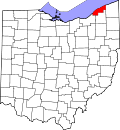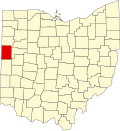
There are 88 counties in the U.S. state of Ohio. Nine of them existed at the time of the Ohio Constitutional Convention in 1802. [1] A tenth county, Wayne, was established on August 15, 1796, and encompassed roughly the present state of Michigan. [2] During the Convention, the county was opposed to statehood, and was not only left out of the Convention, but dissolved; the current Wayne County is in northeastern Ohio, considerably distant from the area that was the original Wayne County. [1]
Contents
The Ohio Constitution allows counties to set up a charter government as many cities and villages do, [3] but only Summit and Cuyahoga counties have done so, [4] the latter having been approved by voters in November 2009. [5] Counties do not possess home rule powers and can do only what has been expressly authorized by the Ohio General Assembly. The elected county officials in Ohio county governments include three commissioners, a sheriff (the highest law enforcement officer in the county); prosecutor (equivalent of a district attorney in other states); coroner, engineer, Recorder, auditor, treasurer, and clerk of courts. [6] [7]
Population figures are based on the 2024 vintage Census population estimates. The population of Ohio was 11,883,304 at that time, an increase of 0.7% from 2020. The average population of Ohio's counties was 135,038; Franklin County was the most populous (1,356,303) and Vinton County was the least (12,545). The average land area is 464 sq mi (1,200 km2). The largest county by area is Ashtabula County at 702.44 sq mi (1,819.3 km2), and its neighbor, Lake County, is the smallest at 228.21 sq mi (591.1 km2). The total area of the state is 40,860.69 sq mi (105,828.7 km2). [8] [9]























































































